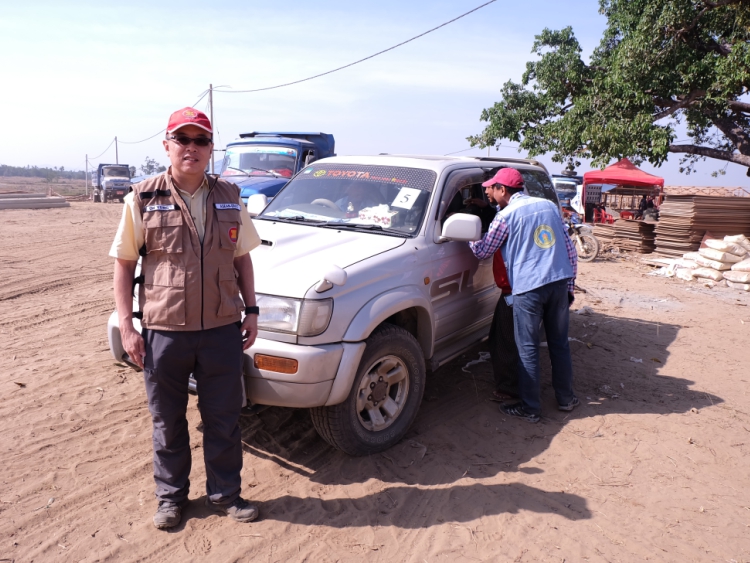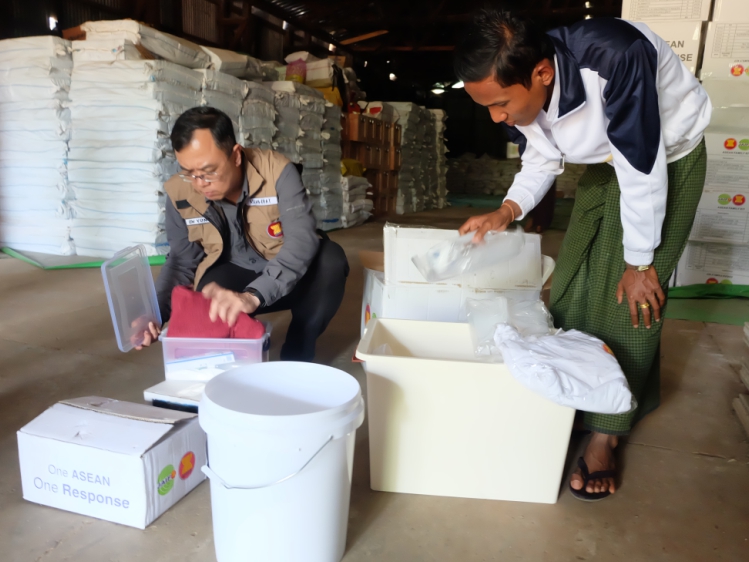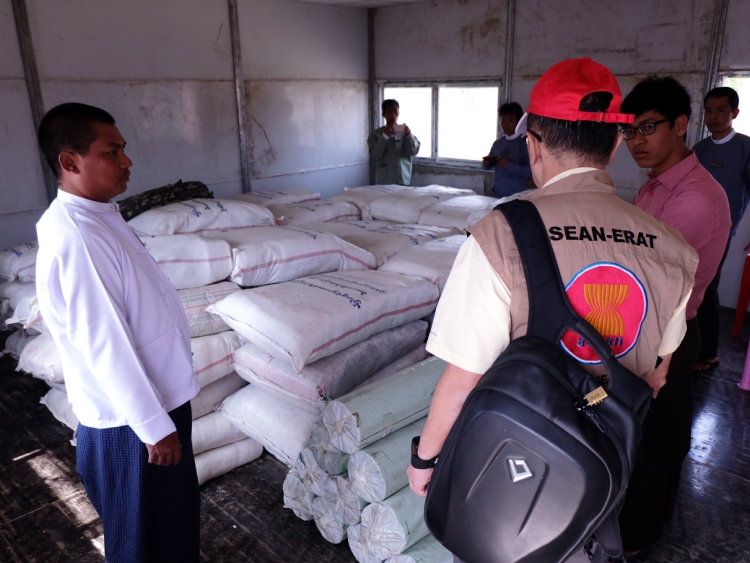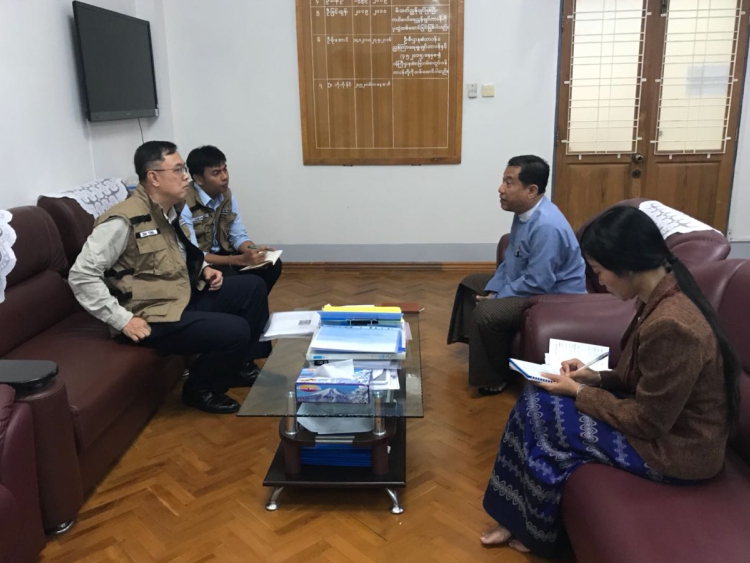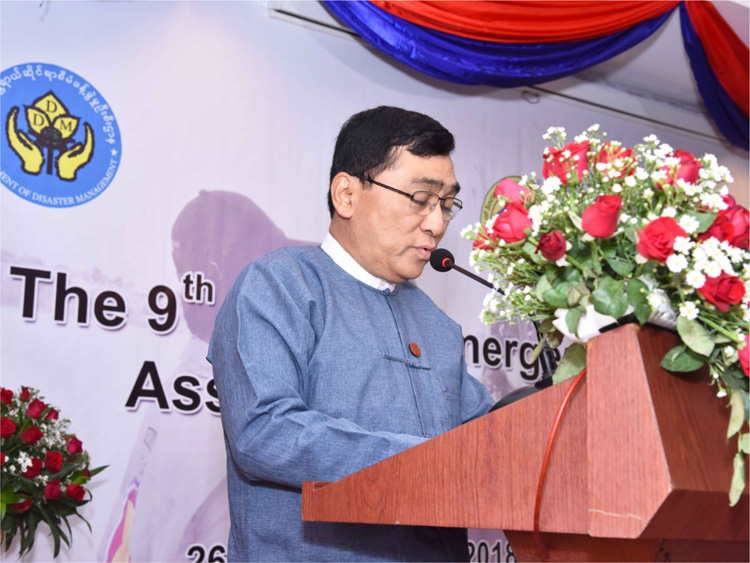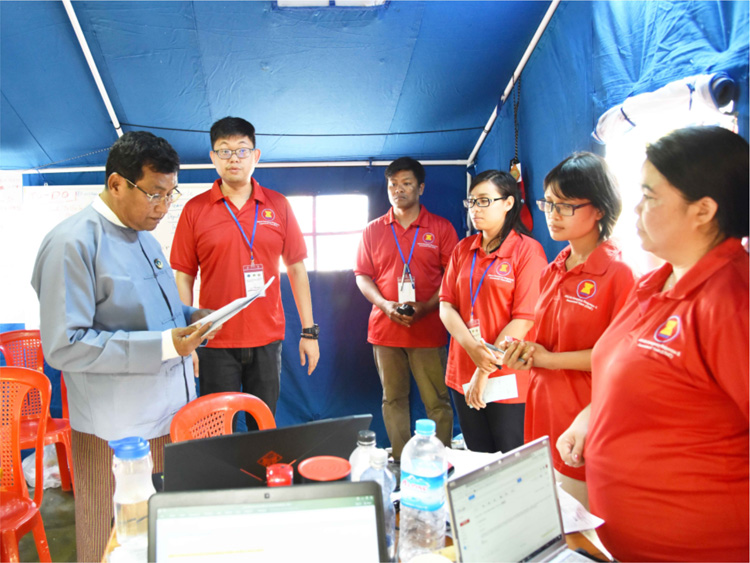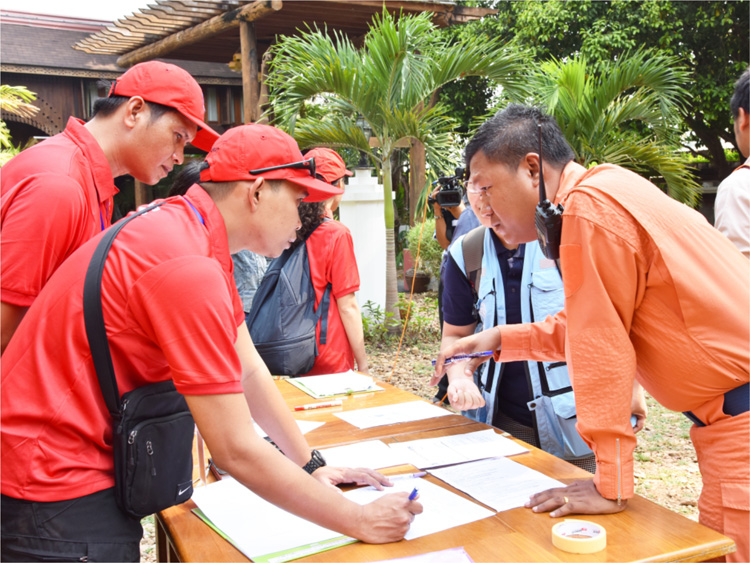Vol 36-ASEAN-ERAT Mission in Rakhine, Myanmar

ASEAN-ERAT
MISSION IN RAKHINE, MYANMAR
As part of its ongoing efforts to assist displaced population in Myanmar’s Rakhine State, the AHA Centre deployed ASEAN Emergency Response and Assessment Team (ASEAN-ERAT) personnel to Myanmar from the 15th – 31st of January, 2018. Tasked to support the work of the Disaster Management Department of Myanmar, the deployed ERAT team was made up of members from the Philippines and Singapore, alongside one AHA Centre staff.
THIS DEPLOYMENT OF ASEAN-ERAT PERSONNEL HAD THREE PRIMARY OBJECTIVES:
1. Observing the status of ASEAN’s relief items that were previously provided through the AHA Centre;
2. Supporting the Emergency Operations Centre (EOC) of Myanmar’s Disaster Management Department with information management, secondary data analysis, and report writing;
3. Undertaking preparations for the next ASEAN-ERAT Induction Course that will be held in Myanmar later in 2018.
Between October 2017 and January 2018, the AHA Centre facilitated the provision of 80 tonnes of relief items, delivered in two batches from the ASEAN regional stockpile in Subang, Malaysia. In December 2017, additional relief items were locally procured by utilising a S$100,000 contribution from the Government of Singapore. Part of this deployment mission included a two-day field observation to Rakhine State, through which the ASEAN-ERAT members confirmed that the distribution of relief items was undertaken as reported by the Disaster Management Department of Myanmar.
The ASEAN-ERAT team also observed the state of temporary shelters, prepared by the Government of Myanmar for displaced communities in Rakhine, as well as those that may return from outside the State. This temporary settlement is equipped with clean water, as well as pre-positioned materials such as clothes, food, and kitchen sets.
In addition to the existing efforts, the Government of Myanmar has developed a stockpile of contingency relief items in Sittwe and Maungdaw, in anticipation of future events, such as flooding, during the approaching monsoon season. Throughout their mission, the ASEAN-ERAT members worked closely with the Director-General and staff of the Disaster Management Department, alongside the Myanmar Red Cross, the General Administration Department in Rakhine, and the Fire Services Departments in Nay Pyi Taw, Yangon, and Rakhine. They worked together conducting a needs assessment, and developing recommendations to further enhance the ongoing provision of humanitarian assistance to the affected communities in Rakhine State.
“THE AHA CENTRE WOULD LIKE TO THANK THE GOVERNMENT OF MYANMAR FOR WELCOMING OUR ASEAN-ERAT MEMBERS TO WORK IN NAY PYI TAW AND RAKHINE STATE. THE MISSION DEMONSTRATES ASEAN’S SOLIDARITY, HELPING ONE ANOTHER IN TIMES OF DIFFICULTY, UNDER THE SPIRIT OF ONE ASEAN ONE RESPONSE,” SAID ADELINA KAMAL, EXECUTIVE DIRECTOR OF THE AHA CENTRE.
Written by : Shintya Kurniawan | Photo : AHA Centre
- Published in Highlight
Vol 38-The 9TH ASEAN-ERAT Induction Course

THE 9TH ASEAN-ERAT
INDUCTION COURSE
Ten years since its first ASEAN-ERAT deployment – to support the response to Cyclone Nargis in Myanmar – the AHA Centre conducted its 9th ASEAN-ERAT Induction Course from the 26th of March until the 1st of April 2018, in Nay Pyi Taw, Myanmar. With outstanding support from the Department of Disaster Management of Myanmar (DDM) as the host, the course was attended by 31 participants from nine of the ten ASEAN Member States. Participants came from an array of backgrounds, including National Disaster Management Organisations, Red Cross and Red Crescent Societies, Civil Society Organisations, Youth Groups, the ASEAN Secretariat, ASEAN Plus Three Emergency Rice Reserve (APTERR), and the AHA Centre itself. The 9th ASEAN-ERAT Induction Course was officially opened with an inspiring speech by Dr. Win Myat Aye, the Union Minister of Social Welfare, Relief and Resettlement of Myanmar.
One of the key features of the 9th course was the simulation exercise scenario – which engaged one of the ASEAN Contingency Plans for large scale disaster – namely a 7.2 magnitude earthquake in Metro Manila. Using this contingency plan scenario, the simulation exercise increased the feeling of authenticity for participants as they performed the ASEAN-ERAT core functions, including rapid damage and needs assessments and incoming ASEAN relief item facilitation. They also enacted the provision of on-site coordination support to the affected country’s local authorities, namely through the facilitation of coordination meetings between a range of ground-level stakeholders.
The simulation exercise also allowed ASEAN-ERAT participants to develop their working relationships with the United Nations Disaster Assessment and Coordination (UNDAC) team, as part of the continued development of inter-operability between the Joint Operations and Coordination Centre of ASEAN (JOCCA) and the UN On-site Coordination Centre. Other components including personnel and team safety and security, as well as working with media were also tested during the simulation exercise. By simulating this response as part of the ASEAN-ERAT course, the AHA Centre has further enhanced the streamlining and capacity of ASEAN-ERAT within the ASEAN Contingency Plan development process.
Of particular note was the enthusiasm and spirit of the participants to deliver results during the non-stop, 48-hour simulation exercise. Given its intensity, the diversity of participants’ backgrounds, and varying skills across the different nationalities, the final results were considerably strong. These diversities and challenges were raised throughout the debrief session, often identified as considerable factors in shared-learning and strengthening the team.
Participants also valued the engagement of a range of external parties, including the United Nations Office for the Coordination of Humanitarian Affairs (UNOCHA), the International Red Cross/Crescent Societies (IFRC), Map Action, Télécoms Sans Frontières, and Myanmar Red Cross amongst others, which provided them the opportunity to familiarise themselves with other key actors who would work alongside them in the field. This also allowed participants to see the importance of stakeholder engagement in achieving the vision of One ASEAN, One Response within the ASEAN-ERAT programme.
The successful completion of the 9th ASEAN-ERAT Induction Course, supported by the Japan-ASEAN Integration Fund (JAIF), alongside other previously-mentioned implementation partners, sees a current pool of 252 ASEAN-ERAT members across the region. Graduates were inaugurated during the Closing Ceremony by Ms. Adelina Kamal, Executive Director of the AHA Centre, together with the Deputy Minister of Social Welfare, Relief and Resettlement of Myanmar, Dr. U Soe Aung and Director General of DDM of Myanmar, Dr. Ko Ko Naing.
“We believe that the benefit of the ASEAN-ERAT goes beyond disaster response and that, because the ERAT teams are composed of government and NGO staff, participants are able to learn skills and get awareness of technologies and practices to take home and use in their current and future projects” – Sebastien Latouille, Delegate of Télécoms Sans Frontière.
“All of the new graduates should feel a great sense of pride. This very demanding course tested each of them and they all came through!” – Oliver Lacey-Hall, Head of UN-OCHA Indonesia/ASEAN Liaison Office.
“During the training, we made mistakes under the stress of the situation. But we could correct our mistakes and overcome the stress by working together and supporting each other as a team. We really appreciate the patience of our facilitators and mentors, for teaching us, for staying with us in the SimEx and sharing your knowledge and expertise with us” – Chan Nyein Thu, ASEAN-ERAT member Batch 9, Department of Disaster Management, Myanmar.
Written by: Grace Endina | Photo: AHA Centre
- Published in Highlight

